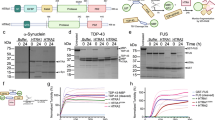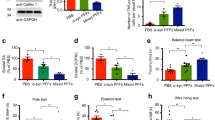Abstract
Parkinson disease (PD) is a neurodegenerative disease characterized by tremor, bradykinesia, rigidity and postural instability. Post-mortem examination shows loss of neurons and Lewy bodies, which are cytoplasmic eosinophilic inclusions, in the substantia nigra and other brain regions1,2. A few families have PD caused by mutations (A53T or A30P) in the gene SNCA (encoding α-synuclein; refs 3, 4, 5). α-synuclein is present in Lewy bodies of patients with sporadic PD (Refs 6,7), suggesting that α-synuclein may be involved in the pathogenesis of PD. It is unknown how α-synuclein contributes to the cellular and biochemical mechanisms of PD, and its normal functions and biochemical properties are poorly understood8,9,10. To determine the protein-interaction partners of α-synuclein, we performed a yeast two-hybrid screen. We identified a novel interacting protein, which we term synphilin-1 (encoded by the gene SNCAIP). We found that α-synuclein interacts in vivo with synphilin-1 in neurons. Co-transfection of both proteins (but not control proteins) in HEK 293 cells yields cytoplasmic eosinophilic inclusions.
This is a preview of subscription content, access via your institution
Access options
Subscribe to this journal
Receive 12 print issues and online access
$209.00 per year
only $17.42 per issue
Buy this article
- Purchase on Springer Link
- Instant access to full article PDF
Prices may be subject to local taxes which are calculated during checkout





Similar content being viewed by others
References
Forno, L.S. Neuropathology of Parkinson's disease. J. Neuropathol. Exp. Neurol. 55, 259–272 (1996).
Pollanen, M.S., Dickson, D.W. & Bergeron, C. Pathology and biology of the Lewy body. J. Neuropathol. Exp. Neurol. 52, 183–191 (1993).
Nussbaum, R.L. & Polymeropoulos, M.H. Genetics of Parkinson's disease. Hum. Mol. Genet. 6, 1687–1691 (1997).
Polymeropoulos, M.H. et al. Mutation in the α-synuclein gene identified in families with Parkinson's disease. Science 276, 2045–2047 (1997).
Kruger, R. et al. Ala30Pro mutation in the gene encoding α-synuclein in Parkinson's disease. Nature Genet. 18, 106–108 (1998).
Spillantini, M.G. et al. α-synuclein in Lewy bodies. Nature 388, 839–840 (1997).
Spillantini, M.G. et al. α-synuclein in filamentous inclusions of Lewy bodies from Parkinson's disease and dementia with Lewy bodies. Proc. Natl Acad. Sci. USA 95, 6469–6473 (1998).
Maroteaux, L., Campanelli, J.T. & Scheller, R.H. Synuclein: a neuron-specific protein localized to the nucleus and presynaptic nerve terminal. J. Neurosci. 8, 2804–2815 (1988).
Jenco, J.M., Rawlingson, A., Daniels, B. & Morris, A.J. Regulation of phospholipase D2: selective inhibition of mammalian phospholipase D isoenzymes by α- and β-synucleins. Biochemistry 37, 4901–4909 (1998).
Clayton, D.F. & George, J.M. The synucleins: a family of proteins involved in synaptic function, plasticity, neurodegeneration and disease. Trends Neurosci. 21, 249–254 (1998).
Chevray, P.M. & Nathans, D. Protein interaction cloning in yeast: identification of mammalian proteins that react with leucine zipper of Jun. Proc. Natl Acad. Sci. USA 89, 5789–5793 (1992).
Lux, S.E., John, K.M. & Bennett, V. Analysis of cDNA for human erythrocyte ankyrin indicates a repeated structure with homology to tissue-differentiation and cell-cycle control protein. Nature 344, 36–42 (1990).
Lupas, A. Prediction and analysis of coiled-coil structures. Methods Enzymol. 266, 513–525 (1996).
Engelender, S. et al. Huntingtin associated protein 1 (HAP1) interacts with dynactin p150Glued and other cytoskeletal related proteins. Hum. Mol. Genet. 13, 2205–2212 (1997).
Withers, G.S. et al. Delayed localization of synelfin (synuclein, NACP) to presynaptic terminals in cultured rat hippocampal neurons. Dev. Brain Res. 99, 87–94 (1997).
Kuzuhara, S. et al. Lewy bodies are ubiquitinated. A light and electron microscopic immunocytochemical study. Acta Neuropathol. 75, 345–353 (1988).
Baba, M. et al. Aggregation of α-synuclein in Lewy bodies of sporadic Parkinson's disease and dementia with Lewy bodies. Am. J. Pathol. 152, 879–884 (1998).
Selkoe, D.J. The cell biology of β-amyloid precursor protein and presenilin in Alzheimer's disease. Trends Cell Biol. 8, 447–453 (1998).
Kim, T.W., Pettingell, W.H., Jung, Y.K., Kovacs, D.M. & Tanzi, R.E. Alternative cleavage of Alzheimer-associated presenilins during apoptosis by caspase-3 family protease. Science 277, 373–376 (1997).
Ross, C.A. Intranuclear neuronal inclusions: a common pathogenic mechanism for glutamine-repeat neurodegenerative diseases? Neuron 19, 1147–1150 (1997).
Conway, K.A., Harper, J.D. & Lansburry, P.T. Accelerated in vitro fibril formation by a mutant α-synuclein linked to early-onset Parkinson disease. Nature Med. 4, 1318–1320 (1998).
El-Agnaf, O.M.A., Jakes, R., Curran, M.D. & Wallace, A. Effects of the mutations Ala30 to Pro and Ala53 to Thr on the physical and morphological properties of α-synuclein protein implicated in Parkinson's disease. FEBS Lett. 440, 67–70 (1998).
Li, X.-J. et al. A huntingtin-associated protein enriched in brain with implications for pathology. Nature 378, 398–402 (1995).
Dawson, V.L. et al. Mechanisms of nitric oxide-mediated neurotoxicity in primary brain cultures. J. Neurosci. 13, 2651–2661.
Uéda, K. et al. Molecular cloning of cDNA encoding an unrecognized component of amyloid in Alzheimer disease. Proc. Natl Acad. Sci. USA 90, 11282–11286 (1993).
Iwai, A., Yoshimoto, M., Masliah, E. & Saitoh, T. Non-Aβ component of Alzheimer's disease amyloid (NAC) is amyloidogenic. Biochemistry 34, 10139–10145 (1995).
Han, H., Weinreb, P.H. & Lansbury, P.T. Jr The core Alzheimer's peptide NAC forms amyloid fibrils which seed and are seeded by β-amyloid: is NAC a common trigger or target in neurodegenerative disease? Chem. Biol. 2, 163–169 (1995).
Heintz, N. & Zoghbi, H. α-synuclein—a link between Parkinson and Alzheimer diseases? Nature Genet. 16, 325–327 (1997).
Nakajo, S. et al. Purification and characterization of a novel brain-specific 14-kDa protein. J. Neurochem. 55, 2031–2038 (1990).
Jakes, R., Spillantini, M.G. & Goedert, M. Identification of two distinct synucleins from human brain. FEBS Lett. 345, 27–32 (1994).
Acknowledgements
We thank G.L. Rudow and C. Zhang for technical support, B.E. Hoffman for providing the primary cultures and M. Delanoy for the assistance with confocal microscopy. This work was supported by a grant from the Parkinson's Disease Foundation, a Pew Fellows Award to S.E., NINDS NS38377 and NS16375, the DeVelbiss fund and a bequest from Sar and Brita Levitan. X.G. is supported by the Herbert Friedburg Fellowship and T.M.D. and V.L.D. are supported by the Edward D. and Anna Mitchell Family Foundation.
Author information
Authors and Affiliations
Corresponding author
Rights and permissions
About this article
Cite this article
Engelender, S., Kaminsky, Z., Guo, X. et al. Synphilin-1 associates with α-synuclein and promotes the formation of cytosolic inclusions. Nat Genet 22, 110–114 (1999). https://doi.org/10.1038/8820
Received:
Accepted:
Issue Date:
DOI: https://doi.org/10.1038/8820
This article is cited by
-
YTHDF2 facilitates aggresome formation via UPF1 in an m6A-independent manner
Nature Communications (2023)
-
Brain regions susceptible to alpha-synuclein spreading
Molecular Psychiatry (2022)
-
Bioengineered models of Parkinson’s disease using patient-derived dopaminergic neurons exhibit distinct biological profiles in a 3D microenvironment
Cellular and Molecular Life Sciences (2022)
-
Cellular and Molecular Events Leading to Paraquat-Induced Apoptosis: Mechanistic Insights into Parkinson’s Disease Pathophysiology
Molecular Neurobiology (2022)
-
The influence of preconditioning with low dose of LPS on paraquat-induced neurotoxicity, microglia activation and expression of α-synuclein and synphilin-1 in the dopaminergic system
Pharmacological Reports (2022)



